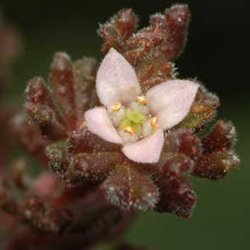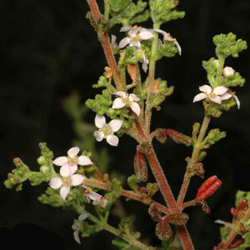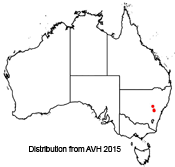Zieria obcordata
 |
 |
Obcordate-leafed Zieria
Zieria obcordata is a member of the Rutaceae which includes the citrus and many showy Australian native plants such as Boronia, Crowea, Correa and Eriostemon.
Zieria obcordata is only known from near Wellington on the Central Slopes of NSW and from near Bathurst on the Central Tablelands of NSW, at altitudes between 500 and 830 metres. Due to its restricted distribution it is listed as endangered under both NSW and Commonwealth legislation.
Zieria obcordata grows in woodland on west to north-west facing slopes in well drained sandy loam soil and often at the base of granite boulders or in the crevices between them. The woodland could be dominated by Eucalyptus, Acacia or Callitris with a low, open and scrubby understory.
Zieria obcordata is a scraggly looking plant with small (about 6mm diameter) pale pink to white flowers. It is, however, attractive when in full flower in late winter to early spring. It has opposite three foliate strongly aromatic leaves. The individual leaflets appear heart shaped due to a recurving of the leaflet tip. The main flowering season is spring, but they do flower sporadically all year. Seed set is also sporadic with the most seed produced in summer. It grows about 0.5 m high and up to 0.8 m wide.
Staff at the Australian National Botanic Gardens have successfully propagated Zieria obcordata from both seed and from cuttings. The seed is first soaked overnight in water; then planted just below the surface of the soil in a regular seed raising mix that will hold water but not too much. Cuttings need to be new but firm growth. After dusting with a rooting powder, the cuttings are planted in a 50:50 mix of perlite and coarse river sand, preferably under heat and humidity control.
To maintain Zieria obcordata in the garden, it will need full sun to part shade and very well drained soil. This species is susceptible to root rot, but has no other pests or diseases. Once it is established, it can tolerate light frosts and periods of dryness. It will appreciate watering during long dry spells. The only fertilising necessary is a very light application of a slow release fertiliser in autumn. Long term cultivation is more successful in containers.
Note: As of 2015, propagation material for Zieria obcordata is not available to the general public.
Ruth Palsson, Botanical Intern 2015
Name meaning: Zieria obcordataZieria - named by Sir James Smith in 1798, in honour of his friend, the Polish botanist, J.Zier who was a Fellow of the Linnaean Society obcordata - from obcordate, meaning heart-shaped and attached at the pointed end |
References:
Armstrong, J. A. (2002). The genus Zieria (Rutaceae): a systematic and evolutionary study. Australian Systematic Botany, 15(3), 277-463.
Australian Native Plants Society (Australia) (2007) The Boronia Family – Propagation. Available at http://anpsa.org.au/boronia2.html [Accessed Feb 2015]
Department of Environment and Conservation (NSW). (2007). Zieria obcordata Approved
Recovery Plan. Department of Environment and Conservation (NSW), Sydney.Department of the Environment. (2015). Zieria obcordata in Species Profile and Threats Database, Department of the Environment, Canberra. Available from: http://www.environment.gov.au/cgi-bin/sprat/ [Accessed Feb 2015]
Knight, J. (1996) Cultivation and Propagation of Boronia and its Relatives, Australian Plants Online. Available at http://anpsa.org.au/APOL4/dec96-1.html [Accessed Feb 2015]
McAuliffe, J. and Feilen, P. (2015), ANBG horticulturalists, personal communication.
Turner, M. (2001) Propagating Boronia, Australian Plants Online. Available at http://anpsa.org.au/APOL23/sep01-1.html [Accessed Feb 2015]
![An Australian Government Initiative [logo]](/images/austgovt_brown_90px.gif)


